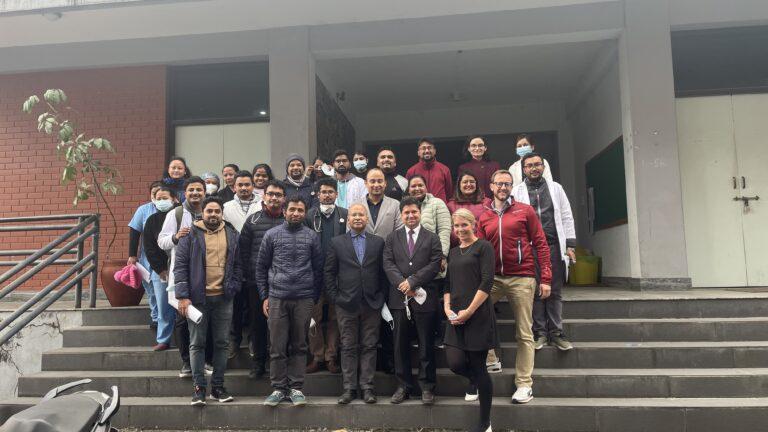When we came to Manipal Teaching Hospital, we learnt quickly, that Manipal will become the role model to prove that small actions will lead to a huge change!
The workshop with 30 physicians and nurses began with Dr. Raju, President of the Nepal Stroke Association, awakening all participants with some devastating facts about strokes worldwide (“1 in 4”). When we then discussed the current obstacles in stroke care in Manipal Teaching Hospital, our impression was that the participants initially felt, most things were out of their area of influence – even though everyone having the strong desire to treat each stroke patient successfully.
As the awareness of stroke in the population is quite low, it’s only a minority of patients arriving in a time window for recanalization. And once the decision for thrombolysis is made – any door-to-needle-time time is prolonged to infinity by the fact that the family itself must raise the money for thrombolysis – and that before the therapy can be started… Currently, thrombolysis is given about 2-3 times/ month (by neurosurgeons, emergency physicians and neurosurgeons), thrombectomy or referral to another center is not yet possible. Dr Raju encouraged the team that the “fear” of thrombolysis will become less and less the more we do it – we just need to get thrombolysis in our routine.
In small groups we worked out how we can save time in the emergency room – and how processes can be streamlined by coordination and standardized protocols. And it was clear to everyone, that their actions in the acute situation will not only make a huge difference in time… but will make the change for the patient’s life. Thanks to Dr. Pradesh’s guidance to CT scan, the physicians gained confidence in interpreting a CT scan in acute stroke patients on their own. We worked out, how the decision for or against thrombolysis is becoming quite simple. And then we all had the opportunity to hear Dr Raju highlighting the importance of stroke unit care and neurosurgery. Finally, Patrick convinced us that Quality Monitoring isn’t only additional pain in stressful days, but that these data are essential for improving clinical care, influencing policy makers – and be recognized for excellence.
Dr. Balgopal, senior neurosurgeon, told everyone to always keep in mind: “Every stroke patient is a potential thrombolysis patient until we find contraindications! So the time is always ticking!” And the new goals in Manipal Hospital are: CT < 30 minutes, Thrombolysis <60 minutes! And no doubt, that these goals are reached!
By the end of the workshop, the room was full of energy and there was a great will to implement small actions that will add to Manipal becoming a stroke center of excellence. The new stroke team, led by Dr. Ashim Subedi and Dr. Balgopal Karmacharya, will set up a stroke call in the ER and start data monitoring with RES-Q right away.
And we are sure, when we meet again in Manipal, all criteria for winning Gold Awards will be already fulfilled.
